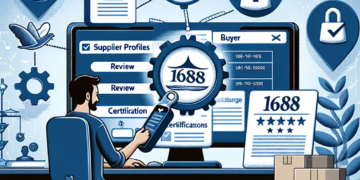Global trade is no longer just about storing products; warehouses must now operate with precision, speed, and advanced technology to respond to market demands.
This is why warehousing logistics trends are transforming the way inventories are managed, orders are prepared, and space is optimized.
This article explores the main innovations in advanced logistics, focusing on how these trends enable more agile, efficient operations that are prepared for a global trade environment.
Warehousing in Global Logistics
For a long time, the purpose of warehousing was to hold inventory until it was needed. However, the growth of e-commerce, globalization, and the demand for faster deliveries have completely changed this landscape.
Today, warehouses are strategic logistics centers that ensure the agility, precision, and efficiency of product flow. And this is why smart warehouses are not only spaces for storage, but also for managing data, optimizing internal routes, and enabling much faster order preparation.
Therefore, poor management can lead to delays, stockouts, or financial losses, while efficient warehouse logistics can become a real competitive advantage.
Technological Trends in Warehousing
Warehousing logistics is undergoing a revolution because, in the face of more demanding and digital global trade, warehouses must cease to be static spaces and become intelligent, automated, and strategic centers.
Below, we analyze the main technological trends that are shaping the future of logistics warehousing.
Automation of Internal Logistics Processes
Automation is one of the pillars of advanced logistics, as more and more warehouses are incorporating technologies such as automated guided vehicles, picking robots, smart conveyors, and automatic sorting systems.
These solutions speed up repetitive tasks such as moving goods, picking orders, or rearranging shelves, reducing human errors and improving overall productivity.
In addition, they free up staff from intensive physical tasks, allowing them to be assigned to more strategic roles.
Implementation of Intelligent WMS Systems
Warehouse Management Systems have evolved significantly in recent years. They are no longer limited to recording product inputs and outputs, but offer complete control over internal warehouse operations, from receiving to shipping.
This visibility and decision automation reduces response times, improves traceability, and allows for anticipating errors or bottlenecks.
Use of IoT for real-time traceability and control
Using smart sensors and devices, it is possible to monitor key variables such as product location, temperature, humidity, movements, and safety conditions in real time.
For example, in sectors such as food and pharmaceuticals, IoT sensors ensure the proper storage of sensitive products, alerting them of critical deviations. Meanwhile, in general warehouses, they allow merchandise to be located instantly and prevent errors in order preparation.
This complete traceability improves decision-making, strengthens quality control, and reduces operational risks.
Big Data and Advanced Analytics in Warehousing
Smart warehousing is not only based on physical technology, but also on data management. Thanks to Big Data, it is possible to analyze large volumes of operational information to optimize logistics processes.
Some key uses include:
- Identifying high-turnover products and redesigning their location to improve efficiency.
- Anticipating seasonal demand peaks and preparing inventory in advance.
- Detecting bottlenecks or inefficient processes that increase logistics costs.
Advanced analytics turns the warehouse into a source of intelligence for the entire supply chain, enabling data-driven decisions without assumptions.
RFID technology for automated inventory control.
The use of radio frequency identification is growing in warehouses seeking greater speed and accuracy in inventory control.
Unlike traditional barcodes, RFID does not require line of sight and allows multiple tags to be read simultaneously.
In addition, it significantly reduces human error and improves stock security, minimizing losses or inventory mismatches.
Cloud Computing and Connected Systems
The cloud makes logistics systems more flexible, scalable, and accessible from anywhere. This makes it possible to manage multiple warehouses from a single platform, share data in real time, and maintain constant synchronization with other players in the logistics chain.
This is especially useful for companies with operations in different locations or that work with third-party logistics providers (3PLs). Furthermore, the cloud reduces infrastructure costs and improves security by keeping data always backed up and up-to-date.
These trends respond to current market demands and anticipate the future of logistics. This allows companies to operate with greater speed, control, and adaptability in an increasingly competitive and globalized environment.
Challenges of Advanced Logistics in Warehousing
Although technology has opened up a range of opportunities to optimize warehousing, it has also brought with it a series of challenges that companies must face if they want to remain competitive.
Advanced logistics not only involves implementing innovative tools but also adapting to a changing environment, with operational, human, and strategic risks.
High initial investment in technology
One of the most common obstacles when modernizing a warehouse is the implementation cost, as incorporating robots, sensors, and advanced systems requires a considerable investment, especially for small and medium-sized businesses.
Lack of trained personnel
A lack of specialized talent or resistance to change on the part of traditional teams can slow technological adoption.
Systems and data integration
Having multiple platforms without real integration can generate more chaos than efficiency. Therefore, if not done correctly, inventory errors, information delays, and traceability issues can arise.
Cybersecurity in connected environments
As warehouses become more digital and operate in the cloud, data protection becomes critical.
A security breach or system breach can compromise sensitive information, impact operations, and generate significant losses. Keep in mind that modern logistics requires robust systems, constant monitoring, and prevention protocols.
Adaptability to External Changes
The global environment is changing rapidly, and this requires flexible systems, scalable processes, and strategic inventory management.
Advanced warehousing logistics offers clear advantages, but its implementation requires planning, training, and a strategic vision.
Future Opportunities in Warehousing Logistics
Companies that adopt a proactive and strategic approach will find real opportunities to improve their performance, reduce costs, and respond more quickly to global market demands.
AI is already demonstrating its potential to predict demand, automate operational decisions, and improve order picking accuracy. Therefore, in the coming years, its integration with analytics systems and platforms will enable even more autonomous, intelligent, and adaptive management.
Logistics flows will also come into play, as thanks to advanced data analysis, warehouses will be able to adapt their processes according to product type, customer behavior, or seasonality, offering a more agile and flexible service without compromising efficiency.
And finally, the logistics of the future will be increasingly connected and collaborative with shared warehousing models, allowing even small businesses to access smart, scalable storage tailored to their real needs.
The challenge is clear, but so are the opportunities. The important thing is to adapt to change to build a more agile, sustainable logistics platform prepared for the global trade of tomorrow.











































































